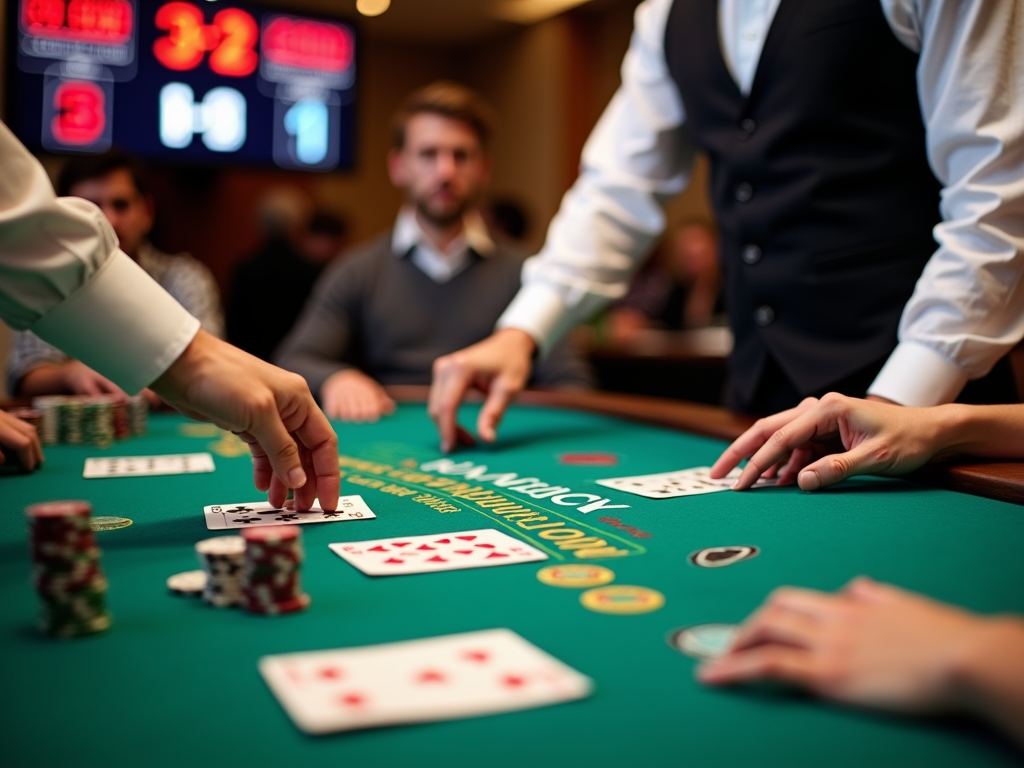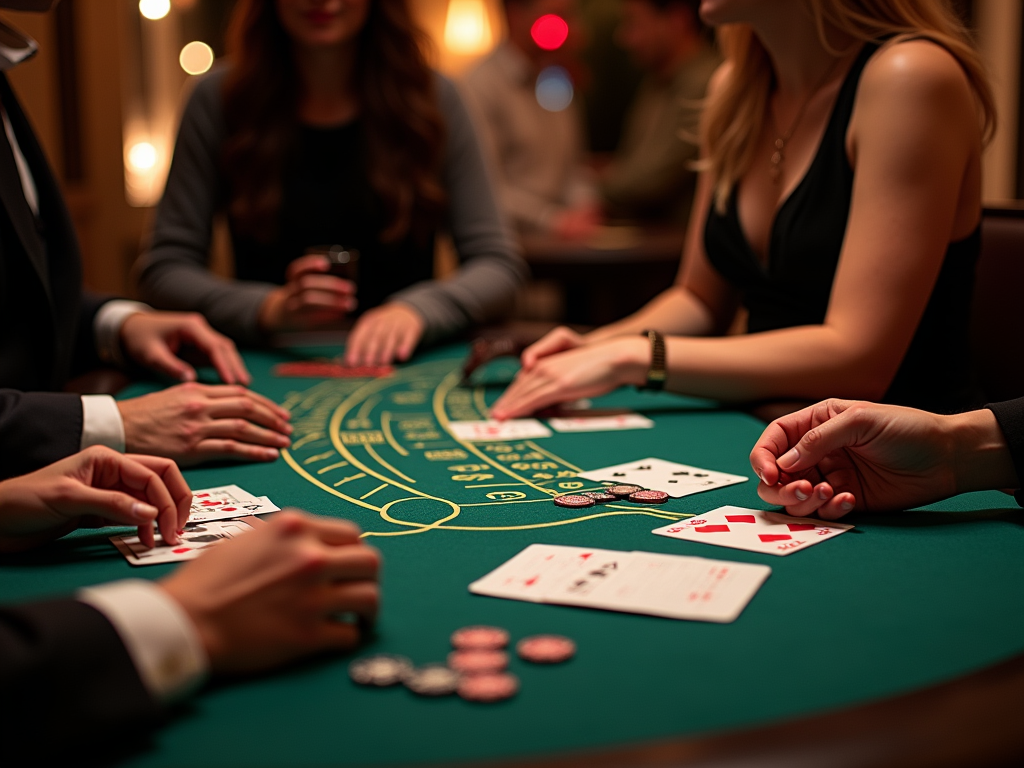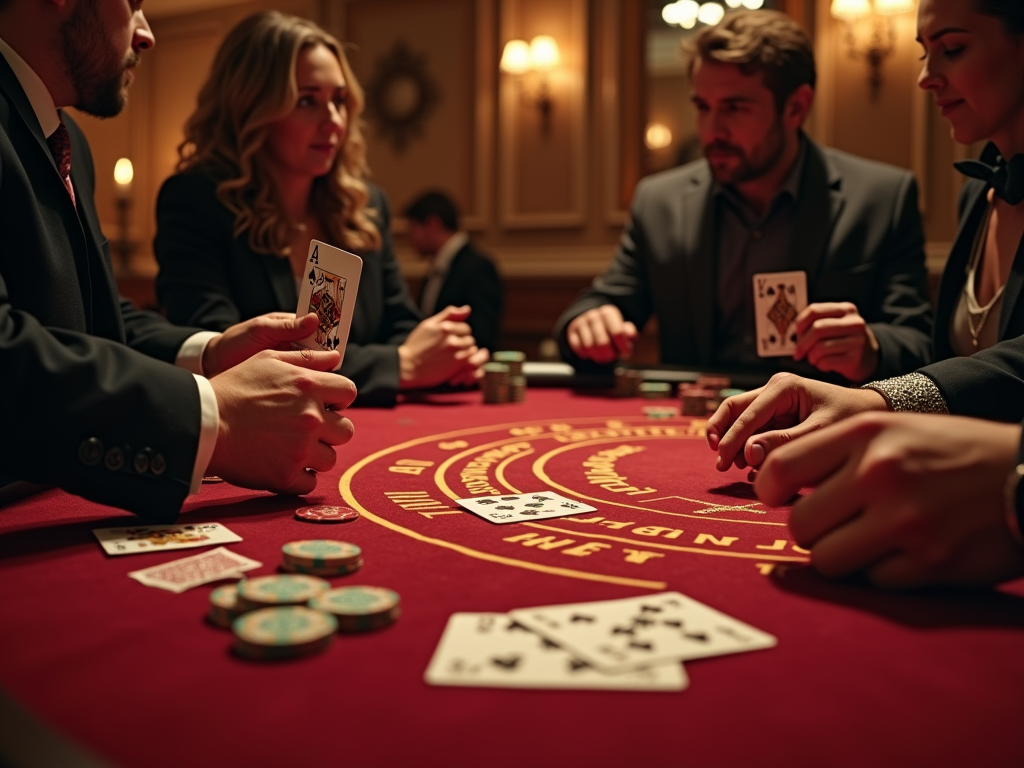Understanding Blackjack Card Values and Strategy
I’ve learned that Blackjack’s simple card values create powerful strategic opportunities at the casino table. The straightforward scoring system lets me focus on making smart decisions throughout each hand.
Key Takeaways
- Numbered cards (2–10) are worth their face value, while face cards (Jack, Queen, King) count as 10 points
- Aces have unique flexibility, counting as either 1 or 11 depending on what benefits your hand
- Basic actions include hitting (requesting another card) and standing (keeping your current hand)
- Strategic moves like splitting pairs and doubling down can improve your odds when used correctly
- Understanding the difference between hard and soft hands is crucial for making optimal decisions
Card Values and Their Strategic Implications
Face cards and 10s hold the same 10-point value, which makes them powerful cards for reaching that perfect 21. The Ace stands out as the most versatile card, adapting between 1 and 11 points to strengthen my position.
Making Strategic Moves
The basic actions form my foundation — I’ll hit to add cards or stand to keep my current total. Advanced plays like splitting matched cards or doubling my bet on strong starting hands can maximize my advantage.
Recognizing Hand Types
I make sure to identify whether I hold a hard hand (no Ace or Ace counting as 1) or a soft hand (Ace counting as 11), since this affects my strategy. Mastering these fundamentals puts me in position to make the best statistical decisions on every hand.
The Essential Card Values Every Blackjack Player Must Know
Understanding Point System in Blackjack
I’ve found that mastering card values is the foundation of successful blackjack play. Newcomers to blackjack will appreciate how straightforward the basic point system is — numbered cards 2 through 10 are worth exactly what they show. It’s as simple as that: a 2 of hearts equals 2 points, a 7 of clubs equals 7 points, and so on.
The face cards follow an equally clear rule. Kings, Queens, and Jacks all carry a value of 10 points, regardless of their suit. So whether you’re dealt a King of spades or a Jack of diamonds, you’re working with 10 points in your hand.
The Ace is the most dynamic card in the deck, and here’s why — it can switch between two values, 1 or 11, depending on what helps your hand the most. Let me break down how this flexibility works in real gameplay:
- Ace + 6 = 7 or 17 points
- Ace + 3 = 4 or 14 points
- Ace + King = 11 or 21 points (blackjack!)
This dual-value feature of the Ace creates exciting strategic options. For instance, if I’m dealt an Ace and a 6, I can count it as 7 (treating the Ace as 1) and safely hit for another card. But I could also stand on 17 (treating the Ace as 11) if the dealer shows a weak upcard like a 5 or 6.
The same principles apply whether you’re playing traditional casino card games or trying your hand at advanced betting strategies. Understanding these card values isn’t just about memorization — it’s about using them to make smart decisions at the table.
This straightforward point system lets you focus on strategy rather than complicated calculations. The real skill comes in knowing when to hit, stand, split, or double down based on these values. By getting these basics down cold, you’ll be ready to build your blackjack expertise and make confident decisions during gameplay.
Master These Basic Blackjack Terms Before Playing
Essential Blackjack Actions and Outcomes
Learning blackjack terms is similar to picking up the basics of any casino card game. I’ll break down the core terminology you’ll need to know before sitting at the table.
The most basic action you’ll take is to “hit” – asking for another card from the dealer. You’ll signal this by tapping the table surface. When you’re satisfied with your cards, you’ll “stand” or “stay” by waving your hand horizontally over your cards to keep your current hand.
Here’s what you need to know about common blackjack terms and their meanings:
- Hit – Request an additional card by tapping the table
- Stand/Stay – Keep your current hand; no more cards wanted
- Bust – Your hand value exceeds 21, resulting in an immediate loss
- Natural Blackjack – Getting an Ace plus a 10-value card in your first two cards
- Push – A tie between you and the dealer, where your bet is returned
The payout structure is straightforward but important to understand. I find it helpful to remember that a natural blackjack (an Ace and 10-value card as your first two cards) pays out at 3:2 odds. This means if you bet $10, you’ll win $15. Regular winning hands pay even money at 1:1 – so a $10 bet wins you an additional $10.
Understanding these terms and betting patterns creates a solid foundation for your blackjack strategy. I recommend practicing these terms and hand signals before playing at a live table. This helps build confidence and ensures smooth gameplay when real money is at stake.
Remember, clear communication with the dealer is crucial. Using the correct terms and appropriate hand signals prevents misunderstandings and keeps the game running smoothly for everyone at the table.

Strategic Moves That Can Improve Your Odds
Essential Blackjack Betting Options
I’ve found that understanding advanced betting moves can make a significant difference in your blackjack success. Double Down is one of the most powerful tools at your disposal — you’re placing an additional bet equal to your original wager in exchange for exactly one more card. This move shines when you’re in a strong position and want to maximize your potential profits.
Splitting pairs opens up exciting opportunities to turn one promising hand into two. When you’re dealt identical cards, you can separate them by matching your original bet, creating two independent hands. Let me share a critical insight: splitting 8s and Aces is often your best move. But keep in mind that many casinos limit you to drawing just one card when splitting Aces.
Protection and Risk Management
Insurance offers a safety net when the dealer shows an Ace, but I need to be clear — it’s not the protective measure many players think it is. While this side bet pays 2:1 if the dealer has blackjack, it carries a substantial 7% house edge for basic strategy players, making it a costly choice in the long run.
Here are key moments when specific strategic moves make sense:
- Double Down when holding 11 and the dealer shows a weaker upcard
- Split pairs of 8s against any dealer upcard to avoid a tough 16
- Split Aces to create two strong starting hands
- Consider Surrender on hard 16 against dealer’s 9, 10, or Ace
The Surrender option can be your escape route from particularly challenging hands, letting you reclaim half your original bet instead of playing out a likely losing hand. I’ve learned that while surrendering might feel like giving up, it’s actually a smart defensive move that can help preserve your bankroll in tough spots.
Want to learn more about maximizing your odds? Check out my complete casino game strategy guide or explore advanced betting systems that can enhance your gameplay.
Hard vs. Soft Hands: Understanding the Difference
Let me explain the essential distinction between hard and soft hands in blackjack, as it’s key to making smart decisions at the table. This core concept affects every strategic choice you’ll make in the game, especially when paired with proper card game strategy basics.
Hard Hands Explained
Hard hands are straightforward – they’re any combination that doesn’t include an Ace, or where the Ace must be counted as 1 to avoid busting. Take a hard 17, made up of a 10 and a 7. There’s no flexibility here – the hand value is fixed at 17. Other examples include:
- 9 + 8 = Hard 17
- 10 + 5 = Hard 15
- Ace + 6 + 10 = Hard 17 (Ace must be 1)
- 4 + 5 + 8 = Hard 17
Soft Hands and Their Advantages
I find soft hands much more exciting to play because they give you extra options. A soft hand always contains an Ace that’s currently being counted as 11. The beauty of soft hands lies in their flexibility – if you hit and risk going bust, the Ace can switch to counting as 1, giving you a safety net.
The classic example is Soft 17 (Ace + 6). What makes this hand special is that you can hit without fear of busting. If you draw a:
- 2: You now have 19 (still soft)
- 3: You now have 20 (still soft)
- 4: You now have 21 (still soft)
- 5 or higher: The Ace converts to 1, giving you a hard hand
This flexibility explains why the basic betting strategy often recommends hitting on Soft 17, while standing on Hard 17. With a soft hand, you’ve got nothing to lose and potentially a better hand to gain.
A soft hand stays ‘soft‘ until you either stand or are forced to count the Ace as 1 to avoid busting. I always tell players to take advantage of this flexibility – it’s one of the few times in blackjack where you can take an aggressive approach with less risk.
Advanced Table Rules and Variations
Surrender Options and Their Impact
I’ve found that knowing when to surrender can significantly improve your gameplay. Early Surrender gives you the option to fold your hand before the dealer checks for blackjack, receiving half your original bet back. This valuable option isn’t commonly available in most casinos today. Late Surrender, the more common variation, lets you give up your hand after the dealer checks for blackjack, still receiving half your bet back.
Split and Double Down Guidelines
Split rules can make a big difference in your strategy and potential winnings. Here’s what I’ve learned about the key variations you’ll encounter at different tables:
- Basic split rules allow you to separate matching cards into two hands by placing an additional bet equal to your original wager.
- Split Aces typically come with special restrictions – you’ll usually only receive one card per Ace.
- Many casinos limit resplitting Aces but allow multiple splits of other pairs up to 3 or 4 hands.
- Double down after splits might be restricted on certain hands or prohibited entirely.
The Insurance bet deserves special attention. It’s only offered when the dealer shows an Ace, letting you place a side bet up to half your original wager. If you’re interested in learning more about betting systems and strategies, I recommend checking out my complete guide to betting systems which covers similar concepts.
Before sitting down at any blackjack table, I always check the specific house rules about splits and surrenders. These variations can significantly impact your optimal playing strategy. For a deeper understanding of card game fundamentals, you might want to review the basic principles of card games which share common elements with blackjack.

Common Winning and Losing Scenarios
Natural Blackjack and Push Situations
A Natural Blackjack – an Ace paired with any 10-value card – stands as the ultimate winning hand in the game. I’ve seen countless players miss the subtle distinction between a Natural Blackjack and other combinations totaling 21. Here’s what makes it special: a Natural Blackjack automatically beats any other hand totaling 21, giving you a sweet 3:2 payout instead of the standard 1:1.
Sometimes you’ll hit a standoff with the dealer, known as a Push. This happens when both you and the dealer have hands of equal value – including two Natural Blackjacks. During a Push, you’ll get your original bet back without winning or losing any money. Think of it as a reset button for that round.
Critical Losing Scenarios
Going bust is the fastest way to lose your bet. Any time your hand exceeds 21, you’ll lose immediately – even if the dealer later busts too. I find this particularly important when deciding whether to hit or stand on borderline hands.
Double Down decisions deserve special attention since they’re permanent. Once you’ve doubled your bet and received your single additional card, that’s it – no more hits allowed. This makes timing crucial, as I’ve learned from watching players double down at the wrong moment and regret it instantly.
Let’s break down the key scenarios that lead to losses:
- Drawing any card that puts your total over 21
- Having a lower hand value than the dealer (when both stay under 21)
- Taking Insurance when the dealer doesn’t have a Blackjack
- Doubling Down and receiving a low-value card
Speaking of Insurance, this side bet only pays off if the dealer shows an Ace and holds a 10-value card underneath. While it might seem like a safe play, Insurance bets typically favor the house in the long run. I’d suggest focusing on basic strategy decisions instead of relying on Insurance to protect your bankroll.

Sources:
Bicycle Cards – How to Play Blackjack
Wikipedia – Blackjack
VSO News – Blackjack Terms: Glossary of Terms & Slang





